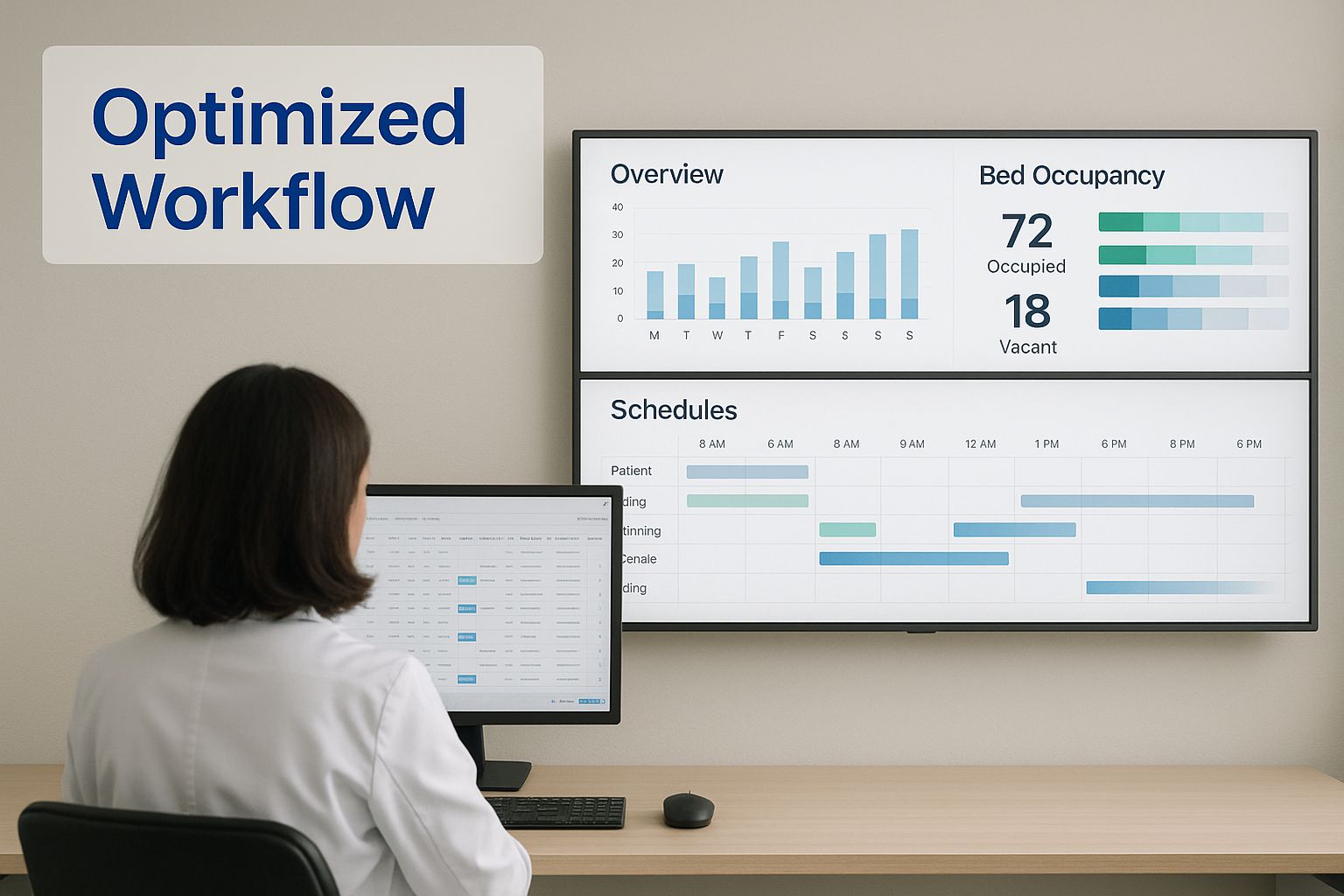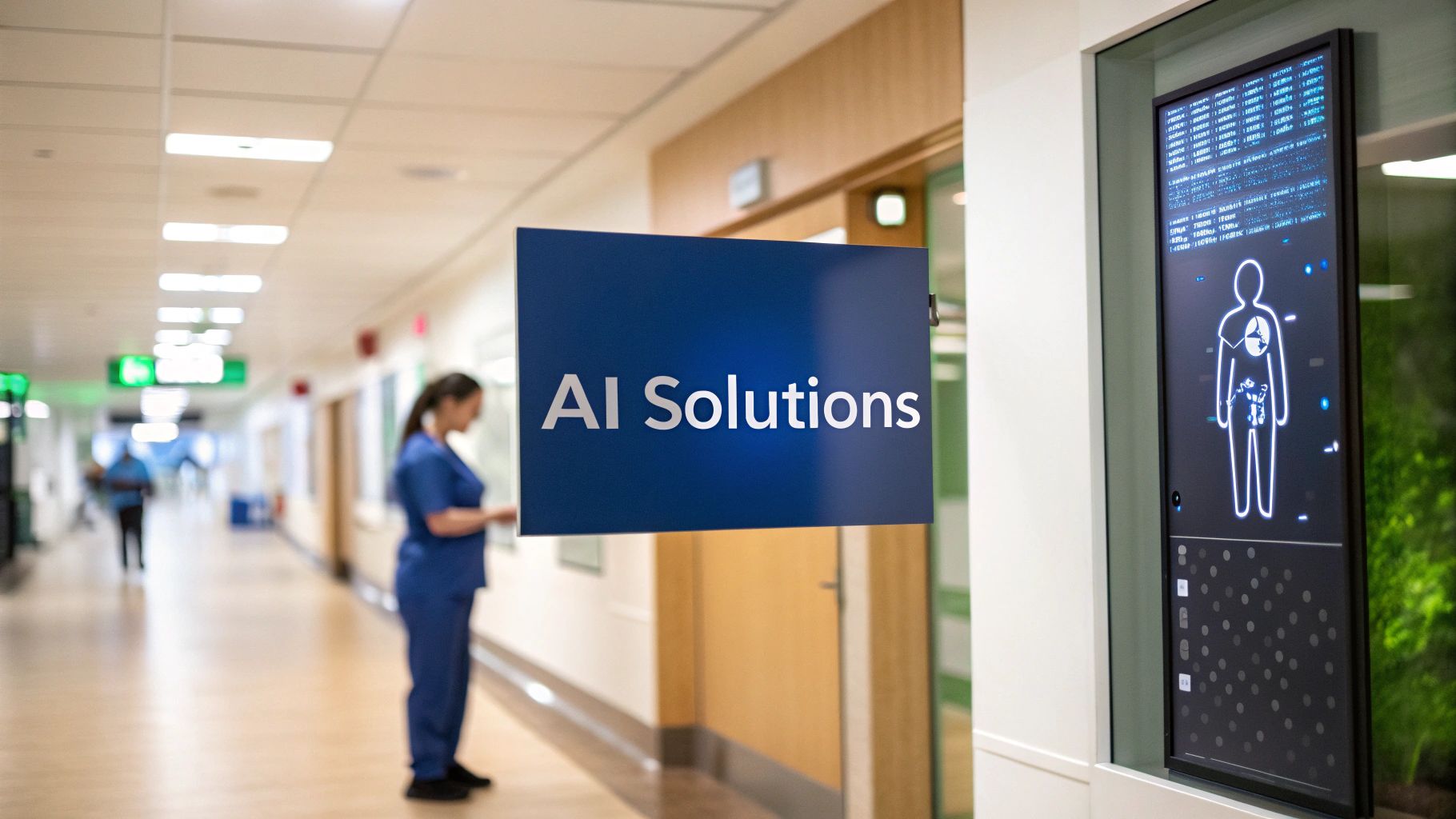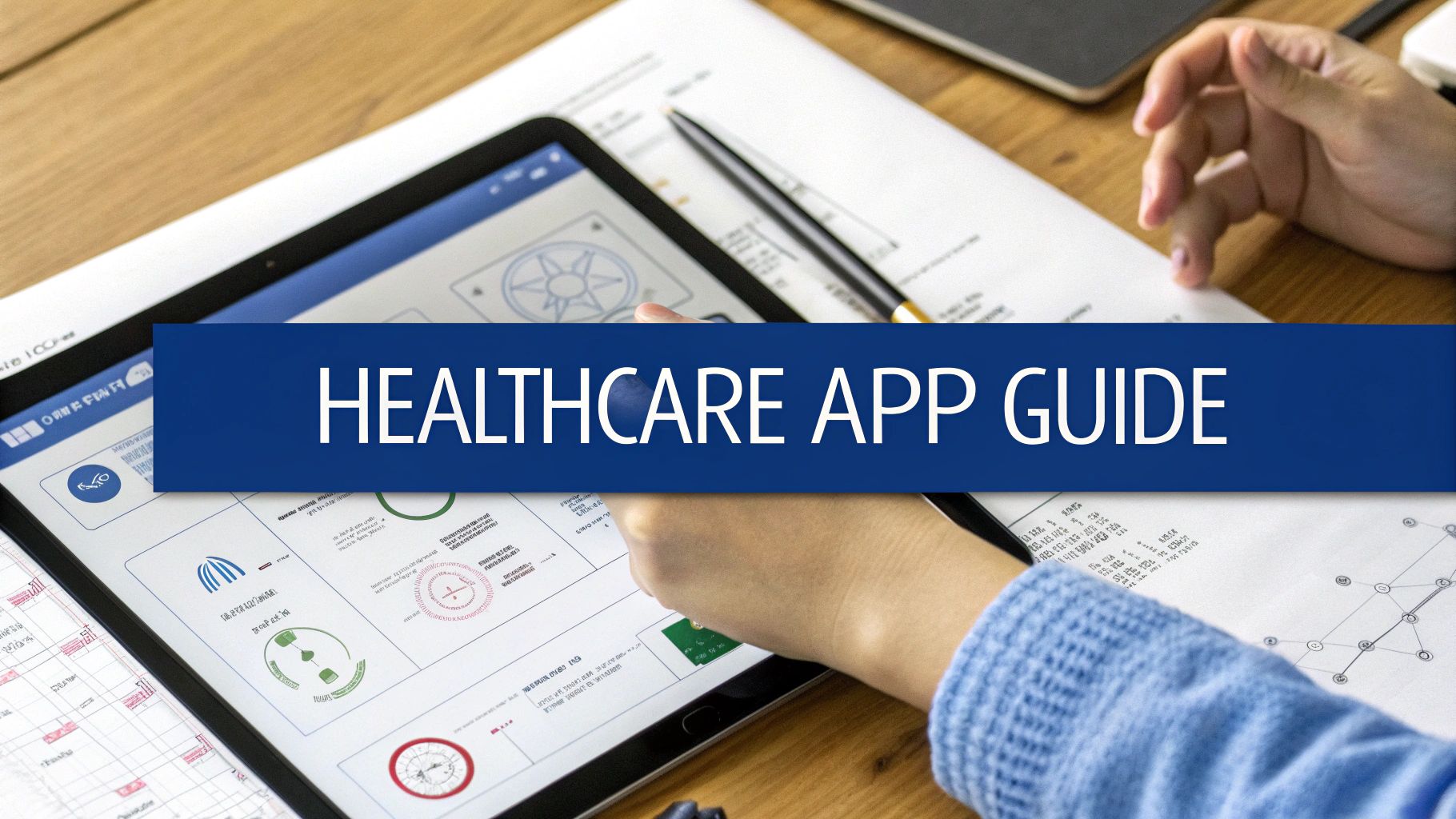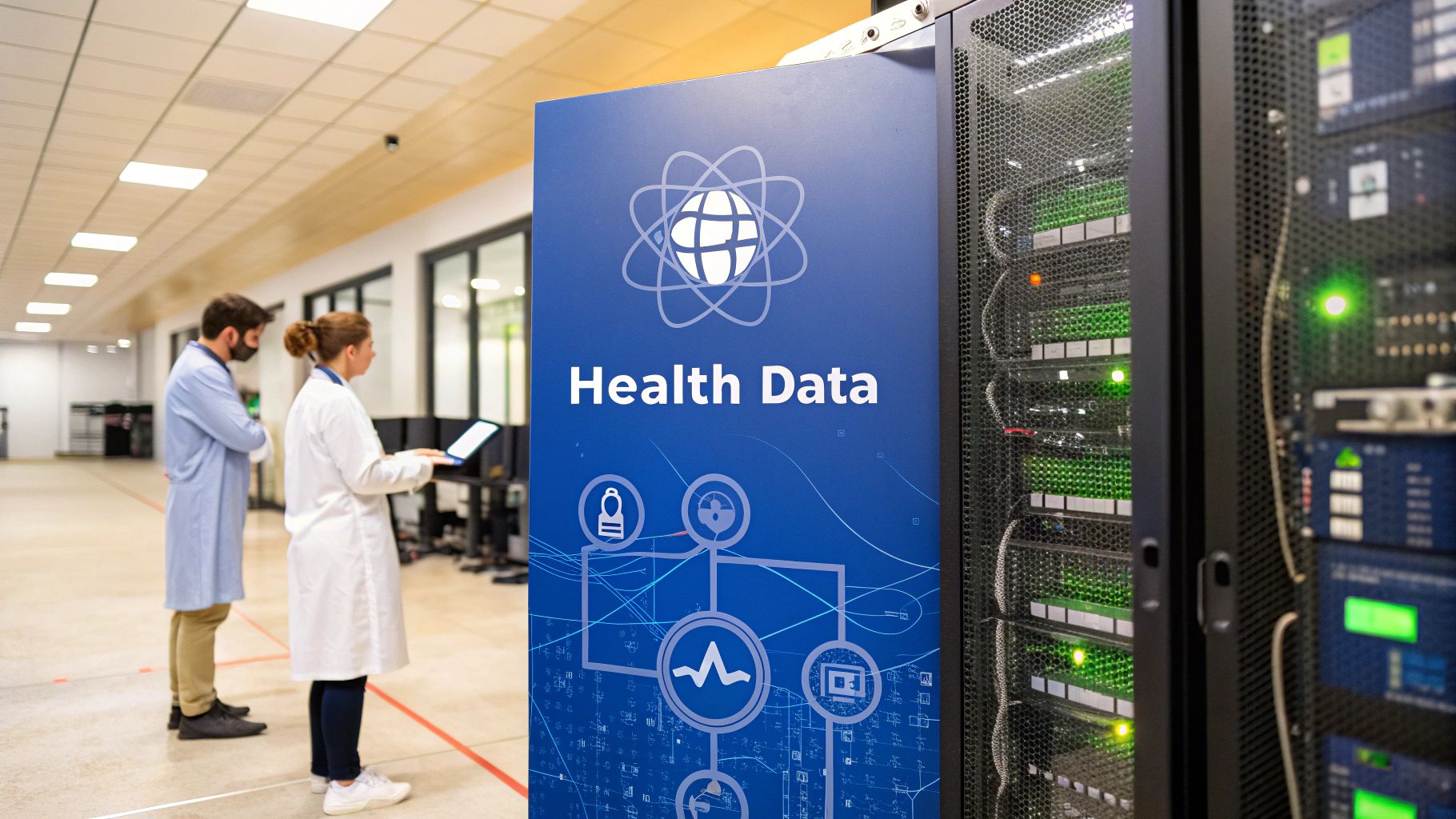Artificial intelligence isn't some far-off sci-fi concept; it's a practical tool that can directly tackle the systemic headaches plaguing Canadian healthcare. For hospitals grappling with everything from crushing administrative burdens to impossibly long patient wait times, AI solutions offer a real path forward to smarter workflows, better data management, and much-needed support for clinical staff.
Confronting Canada's Healthcare Gridlock
Anyone who has interacted with the Canadian healthcare system knows the feeling. The long wait times and administrative overload aren't just abstract problems; they are the lived reality for patients and the dedicated professionals working tirelessly within it. The friction is everywhere, from overcrowded emergency rooms to clinicians spending far too much of their valuable time on paperwork.

This operational strain has very real consequences. The Philips Future Health Index 2025 painted a stark picture, revealing that about one in five Canadians have ended up in the hospital simply waiting for care. The research also found that 45% of patients face long waits for appointments, and for over a quarter of them, this delay caused their health to get worse.
It's not just patients feeling the pressure. The same study found a staggering 85% of clinicians lose time because they can't easily access patient data. You can learn more about these critical healthcare findings, which really drive home the urgent need for change.
The Human Cost of Inefficiency
Behind these statistics are real people. It's the nurse who spends nearly an hour of every shift chasing down incomplete charts instead of being at a patient's bedside. It's the surgeon whose procedure gets pushed back because of a simple bottleneck in bed assignments. These moments add up, leading to widespread staff burnout and, ultimately, affecting the quality of patient care.
The problem isn't a lack of effort or dedication from our healthcare professionals. It's a system groaning under the weight of processes that haven't kept pace with modern demands. Administrative work, while necessary, has become a major roadblock to the core mission of healing.
Introducing a Powerful Ally
This is exactly where AI solutions for hospitals in Canada come in. AI isn’t about replacing people; it’s about giving them a powerful ally to cut through the complexity.
Think of it as a smart assistant that can:
-
Automate the mind-numbing, repetitive administrative tasks that eat up so much clinical time.
-
Analyze operational data to predict patient surges and help manage resources like beds and staff more effectively.
-
Sift through mountains of patient information and present it clearly, supporting faster, more confident decision-making.
By getting to the root causes of the gridlock, AI can help smooth out those inefficient processes and give healthcare teams the support they so desperately need. It's a solution for today's problems, ready to help Canadian hospitals work better for everyone.
How AI is Actively Improving Patient Outcomes
Beyond making hospital operations run smoother, the real magic of AI in Canadian healthcare is how it directly helps patients. We're seeing AI tools move from the lab to the bedside, giving clinicians powerful new ways to deliver faster, more accurate, and deeply personalized care. This isn't about replacing doctors; it's about giving them supercharged, data-driven insights.

Think about it like this: a diagnostic tool can be trained on millions of medical images; far more than any single radiologist could ever hope to see in a lifetime. This AI becomes an incredibly experienced partner, spotting subtle patterns in a scan that the human eye might overlook. The result? Earlier cancer detection and a critical head start on treatment for patients.
In the same way, predictive analytics work like a hospital's early warning system. By constantly monitoring real-time patient data, these models can flag individuals at high risk for serious conditions like sepsis. This gives the clinical team a chance to step in proactively, often well before the patient even starts showing obvious symptoms.
From Prediction to Prevention
The entire focus is shifting from reacting to health problems to actively preventing them from happening in the first place. AI algorithms can sift through a patient's complete health record, lifestyle data, and even genetic information to calculate their risk for future diseases. This opens the door to truly personalized prevention plans, moving us away from one-size-fits-all advice.
AI acts as a vigilant partner for healthcare professionals. It continuously monitors complex data streams, highlighting risks and opportunities for intervention so clinicians can focus their expertise on making the best possible care decisions for each patient.
This proactive approach is where AI solutions for hospitals in Canada truly shine. Instead of just waiting for a patient to get sick, these systems empower providers to act sooner. That leads to much better health outcomes and a more sustainable healthcare system for everyone. You can learn more by exploring our detailed guide on the many benefits of AI in Canadian healthcare.
A Canadian Success Story in Action
This isn't just theory; we're already seeing measurable results. A great example comes from the Canadian company Swift Medical, which developed an AI platform for digital wound care. Their solution uses mobile devices and sophisticated computer vision to help clinicians accurately track and measure wounds over time.
The impact has been incredible. Hospitals using the technology have seen a 14% reduction in wound-related hospitalizations and a 62% decrease in the length of stay for admitted patients. These numbers prove that AI is a practical tool that enhances patient care while making better use of hospital resources. You can read the full analysis on AI's healthcare benefits in Canada for more details.
By bringing these smart systems into the fold, Canadian hospitals are making healthcare more precise, predictive, and patient-centred. They're turning raw data into better health for all of us.
Using AI to Fix Hospital Operations
A hospital’s ability to deliver great care isn't just about what happens at the bedside; it's deeply connected to how well things run behind the scenes. The operational side of a healthcare facility, things like managing patient flow, scheduling staff, and tackling a mountain of paperwork, is often where frustrating delays and bottlenecks build up. This is precisely where AI solutions for hospitals in Canada can make an immediate and powerful impact.
Think of a busy emergency department like an airport's air traffic control tower. Without a smart system directing planes, you’d have chaos, blocked runways, and endless circling. AI serves as that advanced control system for a hospital. It uses predictive analytics to forecast patient admission rates with impressive accuracy, allowing administrators to get ahead of demand, manage bed allocation, and prevent the entire system from grinding to a halt.
This infographic shows what a modern operations control centre looks like, where AI pulls together all the moving parts into one clear picture.

It’s a perfect illustration of how AI can turn countless separate data streams into a single, cohesive view that drives smarter, faster operational decisions.
Automating the Administrative Burden
Beyond keeping patients moving, there's the sheer volume of administrative work that eats up thousands of hours of clinical time. Tasks like medical billing, coding, and transcribing notes are necessary, but they’re also incredibly repetitive. AI-powered automation can handle these duties with speed and precision, freeing up highly skilled professionals to focus on what they were trained to do: care for patients.
For instance, natural language processing tools can listen to a physician's spoken notes and instantly convert them into structured, coded data for the patient's file.
The real goal here is to shift the balance of work. By automating the routine administrative grind, AI lets doctors, nurses, and support staff spend their time and energy where it truly matters; face-to-face with patients. It's not just about efficiency; it's about reducing burnout and improving job satisfaction.
Frustrating administrative hurdles, like getting prior authorizations for procedures, can also be streamlined. Purpose-built AI prior authorization solutions can automatically check requirements and submit the necessary paperwork, cutting down on the delays that frequently stall patient treatment.
A Before and After Scenario
Let’s look at a typical "before" situation. A ward clerk is manually juggling bed requests on a whiteboard. A nurse spends the last hour of every shift buried in paperwork. An administrator is trying to build next month’s staff schedule using last year’s patient data. The entire system is reactive, inefficient, and stressful for everyone.
Now, let's picture the "after" with AI integrated into the workflow:
-
The AI system flags a likely surge in flu admissions and recommends opening a temporary overflow unit two days before the rush hits.
-
The nurse simply dictates their notes into a handheld device, and the system automatically codes and files the report, saving 45-60 minutes of paperwork per shift.
-
The scheduling software analyzes real-time patient data and builds an optimized staff rota that perfectly matches the predicted workload for the coming week.
This is the promise of AI in hospital operations: moving from reactive, chaotic workflows to an intelligent, predictive system that gives healthcare professionals the support they need to do their best work.
Understanding the Core AI Technologies in Healthcare
To get a real sense of how AI solutions for hospitals in Canada are making an impact, it’s helpful to look under the hood. Forget the dense technical jargon for a moment. Instead, let's think of these core technologies as specialized digital experts, each bringing a unique skill to the table.
The three main pillars of AI in healthcare are Machine Learning, Natural Language Processing (NLP), and Computer Vision. They often work together, but each plays a distinct role in turning messy, complex medical data into clear, actionable insights for Canadian healthcare professionals.
Let's break down what each of these technologies does in a hospital setting.
Core AI Technologies in Canadian Hospitals
|
AI Technology |
Primary Function in Hospitals |
Canadian Application Example |
|---|---|---|
|
Machine Learning (ML) |
Learns from vast datasets to identify patterns and predict future outcomes. Think of it as a digital apprentice that gets smarter over time. |
A hospital in Ontario uses an ML model to analyze patient data, predicting who is at highest risk for sepsis, allowing for earlier intervention. |
|
Natural Language Processing (NLP) |
Understands and interprets human language, both spoken and written. It bridges the gap between how we talk and how computers process information. |
A clinic in British Columbia uses NLP to transcribe and categorize doctor-patient conversations, automating the creation of electronic health records. |
|
Computer Vision |
“Sees” and analyzes visual information from medical images like X-rays, CT scans, and MRIs to detect abnormalities. |
A radiology department in Quebec uses a computer vision tool to screen mammograms, flagging suspicious areas for the radiologist to review first. |
As you can see, each technology tackles a different kind of data, but they all share the same goal: helping clinicians make better, faster decisions.
Machine Learning: The Digital Medical Student
At its heart, Machine Learning (ML) is like a tireless medical student that can absorb and learn from immense amounts of information. You can feed an ML model millions of patient records, treatment outcomes, or lab results, and it will start to recognize patterns that a human simply couldn't. It’s not just following pre-programmed rules; it's genuinely learning and improving its own performance over time.
For instance, an ML algorithm can sift through patient data to predict who is most at risk for a hospital-acquired infection. This gives the clinical staff a chance to take preventative measures before a problem even starts, directly boosting patient safety.
Natural Language Processing: The Expert Listener
Natural Language Processing (NLP) is what allows computers to understand, interpret, and even generate human language. Think of it as a brilliant assistant who can listen to a doctor dictating patient notes and instantly pull out the most critical information, like diagnoses, symptoms, medications, and organize it perfectly in an electronic health record.
This is a game-changer for cutting down the administrative load on clinicians. A key part of this is advanced AI voice recognition in healthcare, which is changing how doctors and nurses interact with their systems and freeing them from hours of typing. A surgeon, for example, can just verbally describe a complex procedure, and an NLP tool can generate a detailed, accurate surgical report in seconds.
Computer Vision: The Tireless Observer
Finally, Computer Vision gives a machine the ability to "see" and make sense of visual information, much like our own eyes do. In a hospital, this technology becomes a tireless observer, capable of analyzing thousands of medical images, like X-rays, CT scans, MRIs, with incredible precision.
It's important to remember that Computer Vision doesn’t replace a radiologist. It acts as a second set of highly trained eyes, flagging subtle anomalies or potential areas of concern that might be missed by a human alone. This partnership between human expertise and AI precision leads to earlier, more accurate diagnoses.
These three technologies are the foundation for most modern AI solutions for hospitals in Canada. By learning from data, understanding our language, and interpreting images, they give healthcare providers powerful new ways to improve both how their hospital runs and the quality of care they deliver.
Navigating Canadian Regulations and Ethics in AI
Bringing AI solutions for hospitals in Canada into the fold is a deep commitment to patient trust and safety. The incredible potential of AI has to be carefully balanced with the realities of our country's unique regulatory and ethical landscape. For any hospital, this means creating a solid framework that puts patient privacy, fairness, and total transparency first.
Canada’s tough privacy laws are front and centre. You have the federal Personal Information Protection and Electronic Documents Act (PIPEDA) on one hand, and strong provincial laws like Ontario's Personal Health Information Protection Act (PHIPA) on the other. Together, they set a very high standard for how patient data gets handled. AI systems need to be built from the very beginning to meet these rules, often using methods like data anonymization to shield patient identities while still letting the algorithms do their work. For a closer look, you can read our guide on AI in healthcare and data privacy in Canada.
The Challenge of Algorithmic Fairness
But it’s not just about following the letter of the law. There’s a huge ethical hurdle to clear: algorithmic bias. At the end of the day, an AI model is only as unbiased as the data it learns from. If the historical data it’s trained on already contains health disparities, the AI could accidentally carry those biases forward, or even make them worse. This could lead to worse care for certain groups of patients.
This is exactly why transparency is a must. Hospital leaders and doctors need a clear window into how an AI model makes its decisions. This idea is often called “explainable AI.” Without that clarity, there's no way to check the technology for fairness or to feel confident in its suggestions when a patient's health is on the line.
The guiding principle here is accountability. Hospitals have to be able to confirm that their AI tools are not just clinically accurate but also fundamentally fair, ensuring every single patient benefits from the innovation.
Building a National Framework for Trust
The good news is that Canadian healthcare organizations aren't going it alone. National bodies are already working hard to create a consistent, responsible way to bring AI into healthcare.
The Canadian Institute for Health Information (CIHI) is taking a leading role in this, setting out a strategic plan for using AI ethically and openly across the entire health system. Their work includes developing a responsible AI framework and helping to train staff on this new technology. By working with health organizations and tech companies, CIHI is helping to build an AI ecosystem we can all trust; one that makes our system more efficient and strengthens public confidence. You can learn more about CIHI's AI strategy to see how these efforts are shaping what comes next.
This collaborative push ensures that as AI solutions for hospitals in Canada become more widespread, they are introduced with patient safety and ethical principles as the top priorities, paving the way for a future where technology truly elevates care for everyone.
Your Roadmap for Bringing AI into Your Hospital
Bringing artificial intelligence into your hospital isn’t a single, massive decision; it's a journey. For any hospital leader in Canada looking at AI, the only way to succeed is with a structured, thoughtful approach. Forget the idea of a massive, disruptive overhaul. Instead, think of it as a series of deliberate steps, starting small and building momentum.
The most important first move? Start with a clear, solvable problem.
Don't try to transform the entire hospital at once. Pinpoint one significant bottleneck that’s causing real headaches. Is it the administrative gridlock bogging down your emergency department? Maybe it’s the constant struggle to accurately predict which patients are at high risk for readmission. By identifying a specific, high-impact area, you can set AI up to deliver a measurable win right out of the gate.
Assembling Your AI Implementation Team
Once you’ve got a target in your sights, it’s time to build a dedicated, cross-functional team. This can't just be an IT project; it needs to be a blend of expertise from across the hospital to make sure every angle is covered.
Your ideal team should include:
-
Clinical Champions: Nurses and physicians who are on the floor every day. They know the real-world workflows and can make sure any new tool is actually practical and helpful, not a hindrance.
-
IT and Data Specialists: These are your technical experts. They’ll handle the integration, manage the data, and most importantly, ensure everything is secure and compliant.
-
Administrative Leaders: You need decision-makers who can clear roadblocks, secure resources, and keep the project aligned with the hospital's bigger goals.
This kind of collaborative approach ensures the AI solutions for hospitals in Canada you choose are not just technically sound, but are also genuinely embraced by the people who will depend on them. Without that buy-in from your staff, even the most sophisticated technology is destined to fail.
From Pilot Project to Scalable Success
With your team and a clear goal, you're ready to launch a focused pilot project. It's smart to partner with a technology vendor who really gets the unique demands and regulations of the Canadian healthcare system. The whole point of the pilot is to test the solution in a controlled environment, measure its impact against clear, predefined metrics, and get honest feedback from your frontline staff.
A successful pilot project does more than just test a tool; it builds your business case. It provides the concrete proof needed to get broader support and funding. When you can show tangible value, whether it's time saved, costs cut, or patient outcomes improved, the argument for a wider rollout becomes undeniable.
To scale up effectively, you'll need a well-defined strategy. You can find some excellent guidance on putting together a comprehensive plan by exploring this technology roadmap template, which can help you chart your course. By following this kind of roadmap, Canadian hospitals can thoughtfully integrate AI, sidestep the common pitfalls, and make sure the technology truly serves its ultimate purpose: enhancing patient care.
Common Questions (and Straight Answers) About AI in Canadian Hospitals
Whenever we talk about bringing new technology like AI into hospitals, a lot of questions come up. It's completely understandable. Administrators, clinicians, and even patients want to know what this really means for them. Let's tackle some of the most common concerns head-on.
Will AI Replace Doctors and Nurses?
Simply put, no. The goal isn't to replace the invaluable expertise of our healthcare professionals, but to support them. Think of AI as an incredibly capable assistant.
It can take over the tedious, repetitive tasks, like sifting through thousands of administrative documents or analyzing complex data sets, that eat up so much of a clinician's day. This frees up doctors and nurses to do what they do best: focus on their patients, handle complex medical challenges, and provide the compassionate care that only a human can.
How is Patient Data Kept Secure?
This is, without a doubt, one of the most critical questions. Protecting patient privacy isn't just a priority; it's a legal and ethical requirement. Any AI tool used in a Canadian hospital has to operate under strict federal and provincial privacy laws, like PIPEDA and PHIPA.
Before an AI model is even trained, patient data is typically anonymized or de-identified, stripping it of any personal information.
On top of that, hospitals layer on their own tough security measures. This includes advanced cybersecurity defences, strict controls on who can access data, and solid data governance policies to keep sensitive health information locked down.
What’s the Best First Step for a Hospital?
Don't try to boil the ocean. The smartest way to start is to pick one specific, nagging problem and solve it with a small, focused project.
Maybe it's automating the mind-numbing process of sending out appointment reminders or creating a system to intelligently sort administrative requests. By running a targeted pilot project, a hospital can see the technology in action, measure the real-world results, and get staff comfortable and on board before thinking about a bigger rollout.
At Cleffex Digital Ltd, we specialize in building secure, compliant, and genuinely useful AI solutions for the real challenges Canadian healthcare providers face every day. Discover how our custom software can help your hospital.








